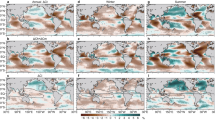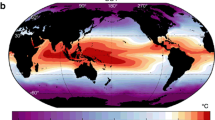Abstract
Intermodel compensation between cloud feedback and rapid cloud adjustment has important implications for the range of model-inferred climate sensitivity. Although this negative intermodel correlation exists in both realistic (e.g., coupled ocean–atmosphere models) and idealized (e.g., aqua-planet) model configurations, the compensation appears to be stronger in the latter. The cause of the compensation between feedback and adjustment, and its dependence on model configuration remain poorly understood. In this study, we examine the characteristics of the cloud feedback and adjustment in model simulations with differing complexity, and analyze the causes responsible for their compensation. We show that in all model configurations, the intermodel compensation between cloud feedback and cloud adjustment largely results from offsetting changes in marine boundary-layer clouds. The greater prevalence of these cloud types in aqua-planet models is a likely contributor to the larger correlation between feedback and adjustment in those configurations. It is also shown that differing circulation changes in the aqua-planet configuration of some models act to amplify the intermodel range and sensitivity of the cloud radiative response by about a factor of 2.








Similar content being viewed by others
References
Andrews T, Gregory JM, Webb MJ, Taylor KE (2012) Forcing, feedbacks and climate sensitivity in CMIP5 coupled atmosphere–ocean climate models. Geophys Res Lett 39(9):L09712. doi:10.1029/2012GL051607
Blackburn M, Williamson DL, Nakajima K et al (2013) The aqua-planet experiment (APE): CONTROL SST simulation. J Meteorol Soc Jpn 91A:17–56
Bony S, Dufresne JL (2005) Marine boundary layer clouds at the heart of tropical cloud feedback uncertainties in climate models. Geophys Res Lett 32(20):L20806. doi:10.1029/2005GL023851
Brient F, Bony S (2013) Interpretation of the positive low-cloud feedback predicted by a climate model under global warming. Clim Dyn 49(9):2415–2431
Caldwell PM, Zelinka MD, Taylor KE, Marvel K (2016) Quantifying the sources of intermodel spread in equilibrium climate sensitivity. J Clim 29(2):513–524
Cess RD, Potter GL, Blanchet JP et al (1990) Intercomparison and interpretation of climate feedback processes in 19 atmospheric general circulation models. J Geophys Res 95(D10):16601–16615
Chung ES, Soden BJ (2015) An assessment of direct radiative forcing, radiative adjustments, and radiative feedbacks in coupled ocean–atmosphere models. J Clim 28(10):4152–4170
Chung ES, Soden BJ, Clement AC (2012) Diagnosing climate feedbacks in coupled ocean–atmosphere models. Surv Geophys 33(3):733–744
Colman R (2003) A comparison of climate feedbacks in general circulation models. Clim Dyn 20(7):865–873
Colman RA, McAvaney BJ (2011) On tropospheric adjustment to forcing and climate feedbacks. Clim Dyn 36(9–10):1649–1658
Dufresne JL, Bony S (2008) An assessment of the primary sources of spread of global warming estimates from coupled atmosphere–ocean models. J Clim 21(19):5135–5144
Forster PM, Andrews T, Good P, Gregory JM, Jackson LS, Zelinka M (2013) Evaluating adjusted forcing and model spread for historical and future scenarios in the CMIP5 generation of climate models. J Geophys Res Atmos 118(3):1139–1150
Gregory JM, Ingram WJ, Palmer MA et al (2004) A new method for diagnosing radiative forcing and climate sensitivity. Geophys Res Lett 31(3):L03205. doi:10.1029/2003GL018747
Held IM, Soden BJ (2006) Robust responses of the hydrological cycle to global warming. J Clim 19(21):5686–5699
Kamae Y, Watanabe M (2012) On the robustness of tropospheric adjustment in CMIP models. Geophys Res Lett 39(23):L23808. doi:10.1029/2012GL054275
Kamae Y, Watanabe M, Ogura T, Yoshimori M, Shiogama H (2015) Rapid adjustments of cloud and hydrological cycle to increasing CO2: a review. Curr Clim Change Rep 1(2):103–113
Klein SA, Hartmann DL (1993) The seasonal cycle of low stratiform clouds. J Clim 6(8):1588–1606
Knutti R (2008) Why are climate models reproducing the observed global surface warming so well? Geophys Res Lett 35(18):L18704. doi:10.1029/2008GL034932
Medeiros B, Stevens B (2011) Revealing differences in GCM representations of low clouds. Clim Dyn 36(1):385–399
Medeiros B, Stevens B, Bony S (2015) Using aquaplanets to understand the robust responses of comprehensive climate models to forcing. Clim Dyn 44(7):1957–1977
Myers TA, Norris JR (2016) Reducing the uncertainty in subtropical cloud feedback. Geophys Res Lett 43(5):2144–2148
Ringer MA, Andrews T, Webb MJ (2014) Global-mean radiative feedbacks and forcing in atmosphere-only and coupled atmosphere–ocean climate change experiments. Geophys Res Lett 41(11):4035–4042
Sherwood SC, Bony S, Boucher O et al (2015) Adjustments in the forcing-feedback framework for understanding climate change. Bull Am Meteorol Soc 96(2):217–228
Slingo JM (1987) The development and verification of a cloud prediction scheme for the ECMWF model. Q J R Meteorol Soc 113(477):899–927
Soden BJ, Held IM (2006) An assessment of climate feedbacks in coupled ocean–atmosphere models. J Clim 19(14):3354–3360
Soden BJ, Vecchi GA (2011) The vertical distribution of cloud feedback in coupled ocean–atmosphere models. Geophys Res Lett 38(12):L12704. doi:10.1029/2011GL047632
Soden BJ, Broccoli AJ, Hemler RS (2004) On the use of cloud forcing to estimate cloud feedback. J Clim 17(19):3661–3665
Soden BJ, Held IM, Colman R et al (2008) Quantifying climate feedbacks using radiative kernels. J Clim 21(14):3504–3520
Stevens B, Bony S (2013) What are climate models missing? Science 340(6136):1053–1054
Taylor KE, Stouffer RJ, Meehl GA (2012) An overview of CMIP5 and the experiment design. Bull Am Meteorol Soc 93(4):485–498
Tomassini L, Geoffroy O, Dufresne JL et al (2013) The respective roles of surface temperature driven feedbacks and tropospheric adjustment to CO2 in CMIP5 transient climate simulations. Clim Dyn 41(11):3103–3126
Vial J, Dufresne JL, Bony S (2013) On the interpretation of inter-model spread in CMIP5 climate sensitivity estimates. Clim Dyn 41(11):3339–3362
Webb MJ, Lambert FH, Gregory JM (2013) Origins of differences in climate sensitivity, forcing and feedback in climate models. Clim Dyn 40(3):677–707
Zelinka MD, Klein SA, Taylor KE et al (2013) Contributions of different cloud types to feedbacks and rapid adjustments in CMIP5. J Clim 26(14):5007–5027
Zhang M, Huang Y (2014) Radiative forcing of quadrupling CO2. J Clim 27(7):2496–2508
Zhang MH, Hack JJ, Kiehl JT, Cess RD((1994) Diagnostic study of climate feedback processes in atmospheric general circulation models. J Geophys Res 99(D3):5525–5537
Acknowledgements
We acknowledge the World Climate Research Programme’s Working Group on Coupled Modeling, which is responsible for CMIP, and we thank the climate modelling groups (listed in Table S1 of this study) for producing and making available their model output. For CMIP the US Department of Energy’s Program for Climate Model Diagnosis and Intercomparison provides coordinating support and led development of software infrastructure in partnership with the Global Organization for Earth System Science Portals. Model output analyzed in this study is available from the Earth System Grid Federation (http://cmip-pcmdi.llnl.gov/cmip5/). We would like to thank two anonymous reviewers for their constructive and valuable comments which led to an improved version of the manuscript. This study was supported by grants from the NASA ROSES Program.
Author information
Authors and Affiliations
Corresponding author
Electronic supplementary material
Below is the link to the electronic supplementary material.
Rights and permissions
About this article
Cite this article
Chung, ES., Soden, B.J. On the compensation between cloud feedback and cloud adjustment in climate models. Clim Dyn 50, 1267–1276 (2018). https://doi.org/10.1007/s00382-017-3682-1
Received:
Accepted:
Published:
Issue Date:
DOI: https://doi.org/10.1007/s00382-017-3682-1




